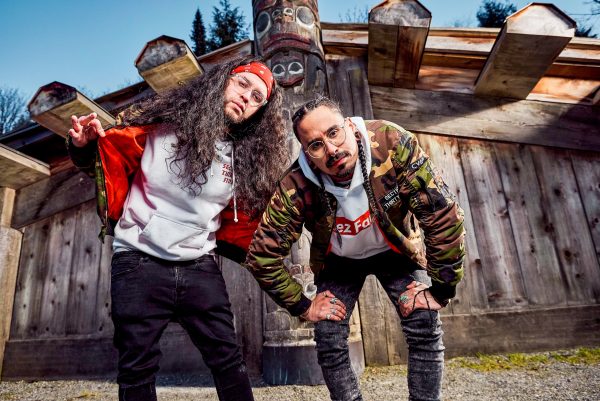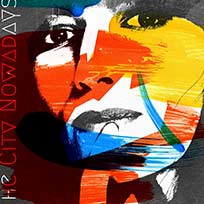
Rhymes and Stories from the City to the Rez
[ad_1]
by: Kyle Mays
November is Native American Heritage Month. But how many people knew that? Better yet, how many people know that Native Americans—the Indigenous people of this land—are still here? During this month, it presents an opportunity for all of us to reflect on a history of genocide, and to consider what we collectively owe to the people upon whose land we all currently live. This month is not just about Thanksgiving, but remembering the struggle of Native Americans who fought valiantly for a future, and it is our job to make sure we remember. According to the 2010 U.S. Census, there are over 5 million Native Americans in the United States. There are 574 federally recognized tribal nations. They are sovereign nations. Their sovereignty pre-existed U.S. colonization and makes them a distinct group from other racial and ethnic groups in the U.S.
What does sovereignty mean? In short, because tribal nations have a treaty relationship with the U.S., they have their own laws, they determine who is a citizen, and many nations, have their own land, called a reservation. They are U.S. citizens, but also citizens of their nation. And no, not every tribe earns casino money nor does every Native person receive scholarships for university. And just because you have an (alleged?) Native ancestor from the distant past based on your DNA test, that does not mean you’re Indigenous. It’s not only about what you claim but who claims you. Still, one of the best representations of Native sovereignty is Native American Hip Hop (NAHH).
NAAH remains one of the longstanding underground Hip Hop scenes that many still have not heard of. What makes their version of Hip Hop unique? They rap about sovereignty, settler colonialism, the daily struggles of living on reservations and in cities, in addition to having fun. According to historian Roxanne Dunbar-Ortiz, settler colonialism is the land theft and genocide that the U.S. government committed against Native people. But they are still here. Native Hip Hop has all of the elements of Hip Hop culture in general. Artists produce knowledge, rap, breakdance, deejay, and also produce graffiti and other forms of visual art. They also have what I call Indigenous Hip Hop Kinship. This kinship is a set of relationships between Native artists, rooted in their specific geographical location, their common experience as colonized people, as well as their connections to tribal nations and clans. I would add two more elements to Native Hip Hop, and that is sovereignty and fashion with a few differences.
Native artists rock Native bling. Native bling is the combination of a beaded medallion, turquoise jewelry, and earrings that are usually worn at powwows. Instead, artists use them in their Hip Hop performances. They not only represent Hip Hop culture in general but let their audiences know that they are sovereign people, with similar and unique struggles on the rez and in the city. However, an accurate representation of what it means to be Native Americans has not always existed in Hip Hop.
From the foundations of Hip Hop, Native stereotypes have been a consistent theme. From the Afrika Bambaataa and Soul Sonic Force’s “Planet Rock” music video to André 3000’s performance at the 2004 Grammys to rap trio Migos use of stereotypes and tropes in their video, “T-shirt”, artists have used Native stereotypes. It is not the fault of Black and Latinx artists, although they were complicity. They learned from Europeans who created what historian Philip Deloria calls ‘playing Indian.’ It is a form of cultural appropriation where a non-Native person dresses in costumes or assume Native people act a certain way because of what they have learned from popular culture. For example, not all tribes wear headdresses. Not all tribal nations live on reservations, in fact, the majority live in cities. Hip Hop Nation has done a great deal to produce protest songs for the Black freedom struggle, but they have a lot more to do to stop engaging in Indian play, among other things.
In this context, Native Hip Hop artists struggle with a double-burden: produce ‘authentic’ Native expressive culture for themselves and their community and also deal with the ever-present Native stereotypes. Given this burden, many artists can sacrifice creative expression for trying to challenge, critique, and disrupt tropes about who they are. Nevertheless, NAAH is diverse, wide-ranging, and covers the endless ground, from the Rez to the hood. Above all, as a representation of what I call NdN Popular culture, the expression of Native cultures and histories, through music, performance art, writing, and aesthetics. NAAH allows Native people to tell their stories, show that they are not a costume, and remind people that, in spite of genocide and continued oppression, they will continue to thrive and live in a good way.
They produce music that is varied, from amusing and uplifting, to critique and protest.
For example, the track, “Boujee Natives,” by the Snotty Nose Rez Kids, is a fun-filled, hyper consumptive video that shows Natives drinking champagne, wearing expensive Native bling, and eating oysters and shrimp. In its exuberant indulgence, a reservation version of the Great Gatsby, the Snotty Nose Rez Kids are able to demonstrate that Native Americans aren’t just stoic people who suffer under the weight of colonization. Instead, they display the spectacle of bourgeoise Natives millennials. Gender is also an important part of NAAH culture.
Native women contribute significantly to NAAH. In the context of the ongoing issue of Missing and Murdered Indigenous women, an salute to Native women’s joy is essential. In a celebration of Native American women, Hip Hop feminists Eekwol and T-Rhyme’s, track, “For Women, By Women,” pays tribute to the vital role that Native women across generations perform in Native communities. Other artists, such as Pooky G, in, “5Th Chamber,” tells the tale of a young Native woman who struggles to grow up in urban poverty, and yet overcomes it, becoming a strong Native feminist ready to take on the world. Native artists like Savage Fam and Alas in the track, “Walking with the Dead,” reminds us that Native suffering is rooted in colonization and that Native people can never freedom can never exist on stolen lands. These stories are important not only for Native youth but also for non-Native peoples, letting them know that they are still here.
Native people across urban contexts illustrate the importance of connecting and working with to make sure that Black Lives Matter. For example, in the track Pay 2 Be Poisoned,” SouFy, who grew up in southwest Detroit, produced important music centered on the ongoing Flint Water Crisis, and the continued assault on poor and working-class populations in Detroit and beyond.
There are other Native American Hip Hop artists from Canada to the U.S. that everyone should check out. As we celebrate Native American Heritage Month, make sure you keep this in mind: that we all live on occupied Indigenous land and consider what we can collectively do to make sure that Black Lives Matter on stolen Indigenous land! The Native American spirit of struggle from 1492 until the present should inspire us to continue the battle for social transformation. It is through NAAH that Native people show that they are still here, fighting for recognition, in Hip Hop, and in the world.
Kyle T. Mays, Ph.D., is an Assistant Professor in the Department of African American Studies, American Indian Studies, and History at UCLA. He is the author of Hip Hop Beats, Indigenous Rhymes: Modernity and Hip Hop in Indigenous North America (SUNY Press, 2018) and has a forthcoming book titled, An Afro-Indigenous History of the United States (Beacon Press, forthcoming, November 2021), which is a part of their award-winning ReVisioning American History series.
[ad_2]
Source link



No Comments